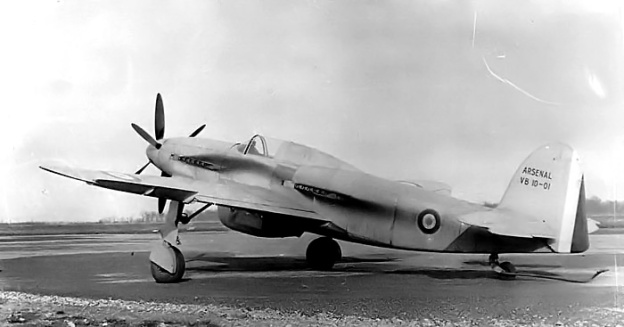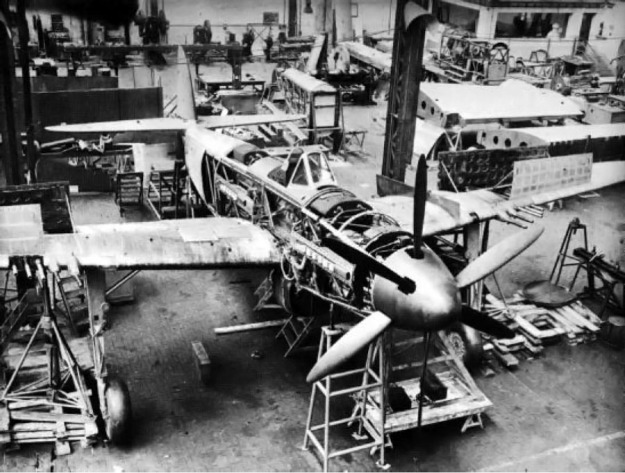In January 1937, the French Air Ministry (Ministère de l’Air) gave Arsenal de l’Aéronautique a contract to develop a twin-engine heavy interceptor fighter built from wood and powered by two 590 hp Hispano-Suiza 12X engines. The engines were to be mounted in tandem inside the fuselage driving contra-rotating propellers in the nose. Through the course of a few designs, this contract evolved into the all-aluminum VB 10 aircraft. The VB 10 was designed in 1938 by Michael Vernisse and M Badie; the initials of their last names formed the ‘VB’ of the aircraft’s designation.

The Arsenal VB 10-01 prototype powered by two 860 hp Hispano-Suiza 12Y-31 V-12 engines. Note the obstructed rear view from the flush canopy.
While the aircraft was of a standard configuration, the engine arrangement was not. One engine occupied the standard position in the nose of the aircraft and a second engine was included behind the cockpit. Each engine drove a set of propeller blades that, together, made up a contra-rotating unit in the nose. The front engine drove the rear propeller, and the rear engine drove the front propeller. The drive shaft from the rear engine ran through the Vee of the front engine and to the front propeller.

The Latécoère 299A that served as an engine test bed for the Arsenal VB 10. The 229A was powered by two 860 hp Hispano-Suiza 12Y V-12 engines, same as the VB 10-01 prototype. Note the front propeller is not turning and the German markings.
With the tide of the war changing, the French restarted construction of the first prototype, VB 10-01, in July 1944. The unarmed prototype was powered by two 860 hp Hispano-Suiza 12Y-31 12-cylinder, liquid-cooled engines and had a flush, sliding canopy with an obstructed rear view. This aircraft was first flown on July 7, 1945 by Modeste Vonner. During initial flight tests, the VB 10-01 achieved a sea-level speed of 304 mph (490 km/h). An order for 200 aircraft was placed on December 22, 1945.

The second prototype VB 10-02 under construction. Note the two 20 mm cannons and three .50-cal machine guns in each wing.
The first production VB 10 made its maiden flight on November 3, 1947. The aircraft was powered by two Hispano-Suiza 12Z-15/16 engines that were rated at 1,300 hp max and 1,150 hp continuous. It was armored with only four 20mm cannons but had provisions to carry one 1,100 lb (500 kg) bomb under each wing. The production aircraft went on to achieve a max speed of 323 mph (517 km/h) at sea-level and 435 mph (700 km/h) at 24,600 ft (7,500 m).
For the VB 10, the beginning of the end occurred on January 10, 1948 when the second prototype, VB 10-02, caught fire while over southern Paris. The pilot, Pierre Decroo, was forced to bail out. He survived but suffered burns. On September 15, 1948, the first production machine crashed in much the same fashion, killing the pilot, Koechlin. Six days later on September 21, 1948, the Arsenal VB 10 contract was cancelled. At the time of cancellation four production VB 10 aircraft, including the one that crashed, had been built. All remaining VB 10s, the first prototype, and three production aircraft were scrapped.

The size of the VB 10 is illustrated here by the crowd in front of the first production VB 10. The aircraft was powered by two Hispano-Suiza 12Z-15/16 engines. Note the 20 mm cannons and no machine guns. Unfortunately this aircraft crashed on September 15, 1948.
The Complete Book of Fighters by Green and Swanborough (1994)
Hispano Suiza in Aeronautics by Manuel Lage (2004)
Jane’s All the World’s Aircraft 1948 by Leonard Bridgman (1948)
http://fr.wikipedia.org/wiki/Arsenal_VB-10
http://en.wikipedia.org/wiki/Arsenal_VB_10
L’ Arsenal de l’Aéronautique by Gérard Hartmann (pdf in French)

No comments:
Post a Comment